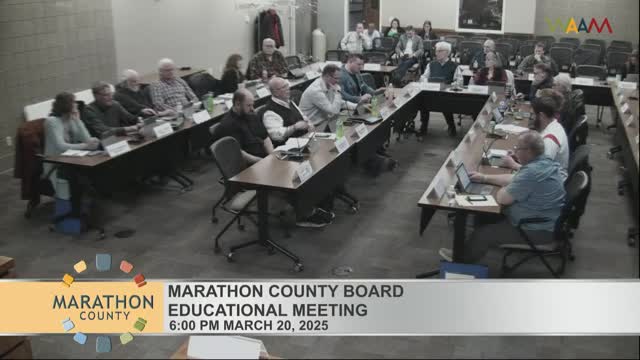Wisconsin County Supervisors Debate Costs of Knowles Nelson Stewardship Program
March 23, 2025 | Marathon County, Wisconsin
This article was created by AI summarizing key points discussed. AI makes mistakes, so for full details and context, please refer to the video of the full meeting. Please report any errors so we can fix them. Report an error »

In a recent Marathon County Board Educational Meeting, discussions centered around the implications of the Knowles-Nelson Stewardship Fund, a program designed to support land conservation and recreational opportunities across Wisconsin. As board members gathered, the atmosphere was charged with a mix of concern and support for the stewardship program, which has historically enjoyed bipartisan backing.
The meeting highlighted a critical tension: while the program aims to enhance public lands and recreational spaces, concerns about its financial impact on taxpayers loomed large. Supervisor Marshall raised a poignant point, questioning the absence of detailed fiscal information regarding the program's costs. He noted that Wisconsin is already grappling with significant debt related to public land purchases, amounting to over $452 million, which translates to a hefty burden of approximately $80 million every two years for taxpayers.
Vice Chair Dickinson echoed these concerns, seeking clarity on the potential costs to individual taxpayers. The discussion revealed that the stewardship program could cost each Wisconsin resident about $11 annually, a figure that could rise for larger families. This led to a broader conversation about the balance between public land ownership and the economic implications for local communities, particularly in areas where government-owned land is prevalent.
Supervisor Sandalski voiced strong opposition to the stewardship grant resolution, arguing that counties with higher private land ownership tend to thrive economically. He pointed out that the poorest counties often have the most government-owned land, which can stifle development and tax revenue. This sentiment was met with counterarguments from other supervisors, who emphasized the program's benefits for local parks and recreational areas, which are vital for community well-being.
Supervisor Robinson highlighted the multifaceted nature of the stewardship fund, noting its role not only in land purchases but also in supporting local projects like park improvements and trail construction. This perspective underscored the program's potential to enhance community infrastructure and recreational opportunities.
As the meeting progressed, the board members grappled with the complexities of land management and conservation. Supervisor Lemmer referenced the county's strategic plan, which emphasizes sound land use decisions that align with economic growth and resource conservation. This plan aims to acquire an average of 320 acres of land annually for public use, a goal that some members questioned in light of the financial implications.
The discussions culminated in a call for more comprehensive data on public land ownership in Marathon County, as members sought to understand the broader landscape of land use and its impact on local economies. The meeting concluded with a commitment to further explore these issues, leaving board members and community members alike pondering the delicate balance between conservation efforts and fiscal responsibility. As Marathon County navigates these challenges, the future of its natural resources and recreational spaces hangs in the balance, awaiting informed decisions that will shape the community for years to come.
The meeting highlighted a critical tension: while the program aims to enhance public lands and recreational spaces, concerns about its financial impact on taxpayers loomed large. Supervisor Marshall raised a poignant point, questioning the absence of detailed fiscal information regarding the program's costs. He noted that Wisconsin is already grappling with significant debt related to public land purchases, amounting to over $452 million, which translates to a hefty burden of approximately $80 million every two years for taxpayers.
Vice Chair Dickinson echoed these concerns, seeking clarity on the potential costs to individual taxpayers. The discussion revealed that the stewardship program could cost each Wisconsin resident about $11 annually, a figure that could rise for larger families. This led to a broader conversation about the balance between public land ownership and the economic implications for local communities, particularly in areas where government-owned land is prevalent.
Supervisor Sandalski voiced strong opposition to the stewardship grant resolution, arguing that counties with higher private land ownership tend to thrive economically. He pointed out that the poorest counties often have the most government-owned land, which can stifle development and tax revenue. This sentiment was met with counterarguments from other supervisors, who emphasized the program's benefits for local parks and recreational areas, which are vital for community well-being.
Supervisor Robinson highlighted the multifaceted nature of the stewardship fund, noting its role not only in land purchases but also in supporting local projects like park improvements and trail construction. This perspective underscored the program's potential to enhance community infrastructure and recreational opportunities.
As the meeting progressed, the board members grappled with the complexities of land management and conservation. Supervisor Lemmer referenced the county's strategic plan, which emphasizes sound land use decisions that align with economic growth and resource conservation. This plan aims to acquire an average of 320 acres of land annually for public use, a goal that some members questioned in light of the financial implications.
The discussions culminated in a call for more comprehensive data on public land ownership in Marathon County, as members sought to understand the broader landscape of land use and its impact on local economies. The meeting concluded with a commitment to further explore these issues, leaving board members and community members alike pondering the delicate balance between conservation efforts and fiscal responsibility. As Marathon County navigates these challenges, the future of its natural resources and recreational spaces hangs in the balance, awaiting informed decisions that will shape the community for years to come.
View full meeting
This article is based on a recent meeting—watch the full video and explore the complete transcript for deeper insights into the discussion.
View full meeting
